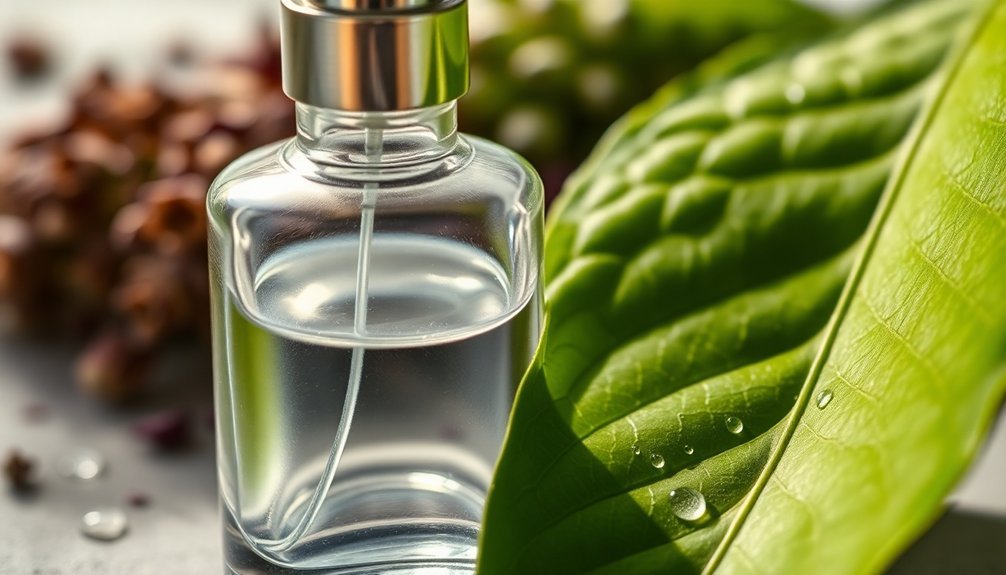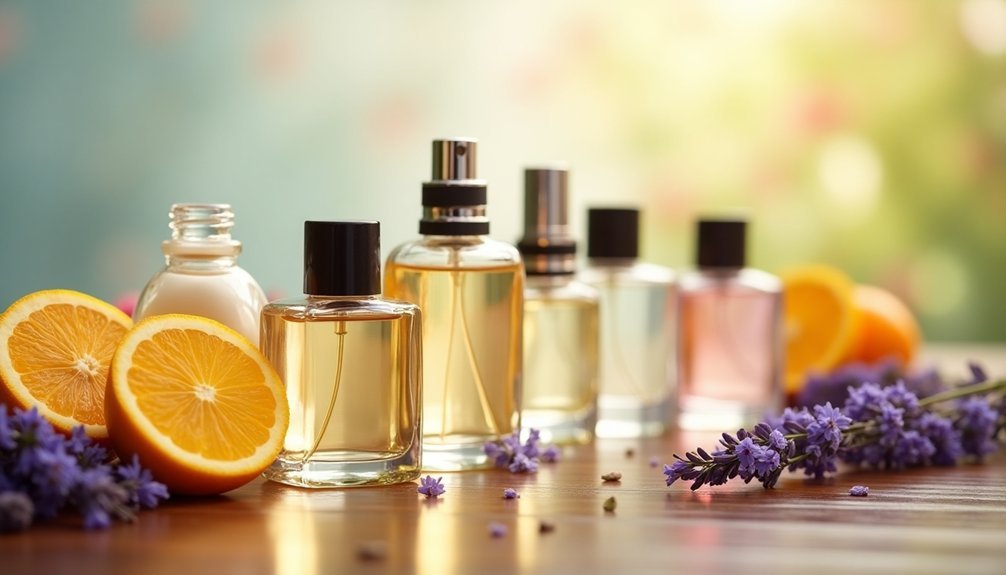You'll achieve perfect fragrance balance by mastering five key techniques used by professional perfumers. Apply scents to 2-3 pulse points for ideal distribution, and choose complementary notes within the same scent family. Layer fragrances from heavy to light, letting each settle before adding the next. Adjust your combinations seasonally, using lighter scents in warm months and richer ones in cold weather. Testing and fine-tuning your blends will reveal the secrets of signature scent creation.
Master Your Pulse Points for Optimal Scent Distribution

When it comes to wearing fragrance effectively, understanding pulse points is vital for maximizing your scent's impact. These strategic spots, where blood vessels run closest to your skin's surface, naturally emit warmth that helps diffuse fragrances more effectively throughout the day. Creating a proper scent trail projection requires these naturally warm areas to help amplify the aromatic molecules.
Focus on applying your perfume to key areas: your wrists, neck, behind the ears, inner elbows, and behind the knees.
Don't overdo it – stick to 2-3 pulse points for balanced distribution. Remember to avoid rubbing the fragrance into your skin, as this can break down the scent molecules. Instead, gently dab if needed.
For best results, moisturize your skin before application, as hydrated skin retains scents longer. You'll find that proper application at these warm spots guarantees your fragrance develops naturally and lasts longer.
Choose Complementary Notes for Lasting Harmony
Creating a balanced fragrance composition requires understanding how different scent notes interact and complement each other. Start by exploring fragrances within the same scent family, as these naturally blend well together.
When layering, combine soft oriental with citrus notes, or floral oriental with mossy and water notes for harmonious results. For the best balance, layer no more than two complex fragrances at once. Applying fragrance to moisturized skin first helps create a longer-lasting foundation for your layered scents.
Apply the stronger scent first, then follow with the lighter one to prevent the subtle notes from fading too quickly. Try pairing woody scents with amber notes, or brighten florals with fresh fragrances.
You can enhance rose middle notes with geranium or ylang-ylang, while citrus top notes work beautifully with bergamot or verbena. Always test combinations on paper first to guarantee they create your desired effect.
Layer Fragrances From Heavy to Light

The art of layering fragrances demands a strategic approach, starting with your heaviest scent as the foundation.
You'll want to apply your strongest, most intense fragrance first to establish a solid base that anchors your scent story. This foundational approach allows base notes to linger effectively throughout the day.
Once you've let your base fragrance settle for a few seconds, layer on lighter scents that complement and enhance the foundation rather than compete with it.
If you're working with fragrances of equal oil concentration, always start with the heavier one to prevent it from overwhelming the lighter notes.
Apply each layer to your pulse points – wrists, neck, and behind ears – where your body heat will help diffuse the scents naturally.
Remember to moisturize your skin beforehand, as hydrated skin helps the fragrance molecules adhere better and last longer.
Perfect Your Seasonal Scent Combinations
Mastering seasonal fragrance combinations elevates your scent wardrobe throughout the year.
For spring, embrace light, airy compositions featuring delicate florals and dewy fruits that capture nature's awakening.
Switch to vibrant summer scents with tropical florals, aquatic notes, and fresh citrus that perfectly match those carefree beach days.
As autumn arrives, shift to cozy fragrances with warm spices, woods, and earthy notes that complement the crisp air and falling leaves.
You'll want deeper, richer scents for winter – think vanilla, gourmand, and resinous notes that feel like wrapping yourself in a plush blanket.
Remember to adjust your fragrance intensity with each season: lighter in warm months, deeper in cold ones.
This seasonal approach guarantees your scents always feel appropriate and harmonious with the environment.
Test and Adjust Your Custom Blend

Once you've selected your seasonal fragrances, developing a custom blend requires careful testing and methodical adjustments to achieve the perfect balance.
Start by testing your combinations using either the test candle method, Q-tip technique, or fragrance strips to evaluate initial scent compatibility.
Follow the 25-45-30 ratio for base, middle, and top notes while building your blend. Use precise measurements with droppers or pipettes, and add modifiers gradually to avoid overwhelming the mixture.
When adjusting, test one change at a time and document each modification in detail.
Don't forget to label your samples and maintain thorough records of your blending process. Let your creation mature before making final adjustments, and use a fragrance wheel to guide your selection of complementary notes.
This systematic approach will help you create consistently balanced custom fragrances.
Frequently Asked Questions
How Long Should I Wait Between Applying Different Fragrance Layers?
You'll want to wait 3-5 minutes between fragrance layers to let each scent fully absorb into your skin. If you're using moisturizer, give it an extra minute to guarantee proper blending.
Can I Layer Fragrances From Different Luxury Brands Together?
Yes, you can layer fragrances from different luxury brands. Just guarantee their notes complement each other, apply the stronger scent first, and let each layer dry before adding the next one.
Will Mixing Fragrances Affect Their Individual Chemical Compositions?
Yes, when you mix fragrances, their chemical compositions will interact and potentially alter each other. You'll notice changes in scent profiles, longevity, and overall performance as the different molecules react and combine together.
How Many Different Fragrances Can I Safely Layer at Once?
You can safely layer up to three fragrances at once, but it's best to stick with one or two. More than three can create an overwhelming scent and cause discomfort or headaches.
Should I Store My Layered Fragrance Mixture for Future Use?
You shouldn't store pre-mixed fragrance layers, as they can interact unpredictably over time. Instead, layer your fragrances fresh each time you wear them to maintain their individual qualities and guarantee the best results.
In Summary
Now you've got the essential tools to create your perfect fragrance balance. Remember to focus on those key pulse points, pair complementary notes, and layer strategically from heavy to light bases. Don't forget to adjust your scent choices with the changing seasons and always test your combinations before heading out. With these tips, you'll master the art of personal fragrance and leave a memorable olfactory impression wherever you go.





Leave a Reply